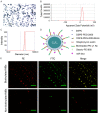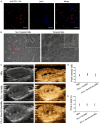Synergistic anti-tumor effect of anti-PD-L1 antibody cationic microbubbles for delivery of the miR-34a gene combined with ultrasound on cervical carcinoma
- PMID: 33841635
- PMCID: PMC8014418
Synergistic anti-tumor effect of anti-PD-L1 antibody cationic microbubbles for delivery of the miR-34a gene combined with ultrasound on cervical carcinoma
Abstract
This study explored the synergistic effect of anti-PD-L1 antibody cationic microbubbles (MBs) for delivery of the miR-34a gene combined with ultrasound in inhibiting the cervical cancer. H&E stain, TUNEL, immunohistochemistry and RT-PCR were used to detect the change of apoptosis regulatory factors, and immunofluorescence, Flow cytometry and LDH assays were applied to evaluate the changing of immunomodulatory. In this experiment the PD-L1 Ab/miR-34a-MBs were prepared successfully. The cell targeting assay showed that U14 cells were surrounded by the PD-L1 Ab/miR-34a-MBs and microbubbles had well contrast imaging capability in vivo. With the irradiation power was 1 W/cm2 and the irradiation time was 25 s, the gene transfection efficiency was the highest using EGFP plasmid lorded microbubbles. In vivo anti-tumor assays, the PD-L1 Ab/miR-34a-MBs showed a great potential in inhibiting tumor growth with a TGI of >50%. PD-L1 Ab/miR-34a-MBs treatment enhanced the anti-tumor effect compared with that induced by PD-L1 Ab or miR-34a alone. Firstly, PD-L1 Ab/miR-34a-MBs could gather miR-34a with high-concentration aggregation and releasing around the cervical cancer, which takes a significant role in promoting apoptosis by downregulated Bcl-2 and upregulated Bax. Furthermore, combination therapy was found to augment the activation of T lymphocytes proliferation and increase CD8+ T cells infiltration, to enhance antitumor immune killing effect. The anti-PD-L1 antibody microbubbles for delivery miR-34a gene with ultrasound were considered to be a promising combination therapy regimen via initiating apoptotic mechanism of the tumor and anti-tumor immune regulation.
Keywords: Ultrasound; anti-PD-L1 antibody; cervical cancer; miR-34a; microbubbles.
AJTR Copyright © 2021.
Conflict of interest statement
None.
Figures








Similar articles
-
Ultrasound-Mediated Co-Delivery of miR-34a and sPD-1 Complexed with Microbubbles for Synergistic Cancer Therapy.Cancer Manag Res. 2020 Apr 5;12:2459-2469. doi: 10.2147/CMAR.S238643. eCollection 2020. Cancer Manag Res. 2020. PMID: 32308482 Free PMC article.
-
Synergistic anti-tumor effect of paclitaxel and miR-34a combined with ultrasound microbubbles on cervical cancer in vivo and in vitro.Clin Transl Oncol. 2020 Jan;22(1):60-69. doi: 10.1007/s12094-019-02131-w. Epub 2019 May 15. Clin Transl Oncol. 2020. PMID: 31093891
-
Ultrasound targeting of microbubble-bound anti PD-L1 mAb to enhance anti-tumor effect of cisplatin in cervical cancer xenografts treatment.Life Sci. 2020 Dec 1;262:118565. doi: 10.1016/j.lfs.2020.118565. Epub 2020 Oct 7. Life Sci. 2020. PMID: 33038371
-
A Systematic Review on the Therapeutic Potentiality of PD-L1-Inhibiting MicroRNAs for Triple-Negative Breast Cancer: Toward Single-Cell Sequencing-Guided Biomimetic Delivery.Genes (Basel). 2021 Aug 4;12(8):1206. doi: 10.3390/genes12081206. Genes (Basel). 2021. PMID: 34440380 Free PMC article.
-
Regulation of PD-L1: a novel role of pro-survival signalling in cancer.Ann Oncol. 2016 Mar;27(3):409-16. doi: 10.1093/annonc/mdv615. Epub 2015 Dec 17. Ann Oncol. 2016. PMID: 26681673 Review.
Cited by
-
Targeted Microbubbles for Drug, Gene, and Cell Delivery in Therapy and Immunotherapy.Pharmaceutics. 2023 May 30;15(6):1625. doi: 10.3390/pharmaceutics15061625. Pharmaceutics. 2023. PMID: 37376072 Free PMC article. Review.
-
Ezrin Modulates the Cell Surface Expression of Programmed Cell Death Ligand-1 in Human Cervical Adenocarcinoma Cells.Molecules. 2021 Sep 17;26(18):5648. doi: 10.3390/molecules26185648. Molecules. 2021. PMID: 34577118 Free PMC article.
-
Targeted Nanobubbles of PD-L1 mAb Combined with Doxorubicin as a Synergistic Tumor Repressor in Hepatocarcinoma.Int J Nanomedicine. 2022 Sep 7;17:3989-4008. doi: 10.2147/IJN.S376172. eCollection 2022. Int J Nanomedicine. 2022. PMID: 36105615 Free PMC article.
-
Revolutionizing cancer therapy: nanoformulation of miRNA-34 - enhancing delivery and efficacy for various cancer immunotherapies: a review.Nanoscale Adv. 2024 Sep 20;6(21):5220-57. doi: 10.1039/d4na00488d. Online ahead of print. Nanoscale Adv. 2024. PMID: 39309515 Free PMC article. Review.
-
Anti-tumor effects of miR-34a by regulating immune cells in the tumor microenvironment.Cancer Med. 2023 May;12(10):11602-11610. doi: 10.1002/cam4.5826. Epub 2023 Mar 23. Cancer Med. 2023. PMID: 36951490 Free PMC article. Review.
References
-
- Bray F, Ferlay J, Soerjomataram I, Siegel RL, Torre LA, Jemal A. Global cancer statistics 2018: GLOBOCAN estimates of incidence and mortality worldwide for 36 cancers in 185 countries. CA Cancer J Clin. 2018;68:394–424. - PubMed
-
- Couzin-Frankel J. Breakthrough of the year 2013. Cancer immunotherapy. Science. 2013;342:1432–1433. - PubMed
LinkOut - more resources
Full Text Sources
Research Materials
